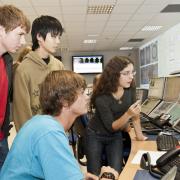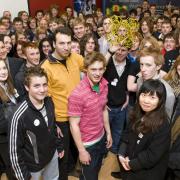Access to Collaboration Site and Physics Results

Every spring, hundreds of universities around the world open their doors to high-school students for a day to give them hands-on experience in particle physics. The International Masterclass programme gives students the chance to use real data collected by the ATLAS detector and other LHC experiments to test the Standard Model and search for new particles.
This year, almost 14,000 students took part in masterclasses held in over 200 institutes from 52 countries. “Every year we see more students taking part in the classes, as they enjoy interacting with professional scientists,” says Uta Bilow, science communicator at TU Dresden who coordinates the Masterclass programme. “The fact that the data are real and coming from the cutting-edge LHC experiments grabs the attention of the students, giving them a taste of how research is being done today.”
Around 7,000 of these students looked at ATLAS data, using modified versions of the ATLAS event visualisation software, Atlantis, to identify particles. They followed one of two programmes: the “W-path” (developed by TU Dresden, Germany) or the “Z-path” (developed by the University of Oslo, Norway).
By going through an analysis for themselves, students learn how a scientific discovery can be claimed.

For the W-path, students searched the data for events where a W boson had been produced and then decayed to an electron or muon, and a neutrino. By measuring the ratio of the number of positively to negatively charged W bosons, students were able to probe the structure of the proton and learn about its constituents. Hidden in the data were a few events identified by ATLAS physicists as containing Higgs bosons decaying to pairs of W bosons, and the students were asked to try and find these too.
Students following the Z-path searched for pairs of electrons or muons and calculated their invariant mass. By plotting the masses of all of the pairs, students were able to identify several different particles: the J/ψ meson, the Υ meson and the Z boson. A handful of simulated “new physics” events were also included that contained “Z prime” bosons, a heavy partner of the Z boson predicted by many new theories.
“By going through an analysis for themselves, our students learned how a scientific discovery can be claimed,” said Magnar Bugge, ATLAS researcher with the University of Oslo, one of the authors of the Z-path exercise and local organiser of the Oslo masterclasses. “We were asked excellent questions from both students and teachers, who seemed to find it an exciting and educational experience.”
At the end of the day, students joined a video conference hosted by LHC researchers to share their findings and combine their results with another four or five institutes from around the world. The students got a taste of how physicists work together internationally and experienced the benefits of combining results from different sources. They were also able to compare their measurement to the published ATLAS result and the theoretical prediction.
A highlight for many was the opportunity to ask physicists questions about life, the universe and everything. “It was a lot of fun,” said Muhammad Alhroob, ATLAS researcher at the University of Oklahoma and moderator for the masterclass video conferences. “The students can talk to real physicists doing real research instead of reading about it in books or in the media. I didn’t have this opportunity until I started doing my Master’s degree.”
Although the 2018 masterclass programme has come to an end, students and teachers worldwide are encouraged to look ahead to next year. Visit the International Masterclasses website to connect with local physicists and institutes collaborating with the programme.






